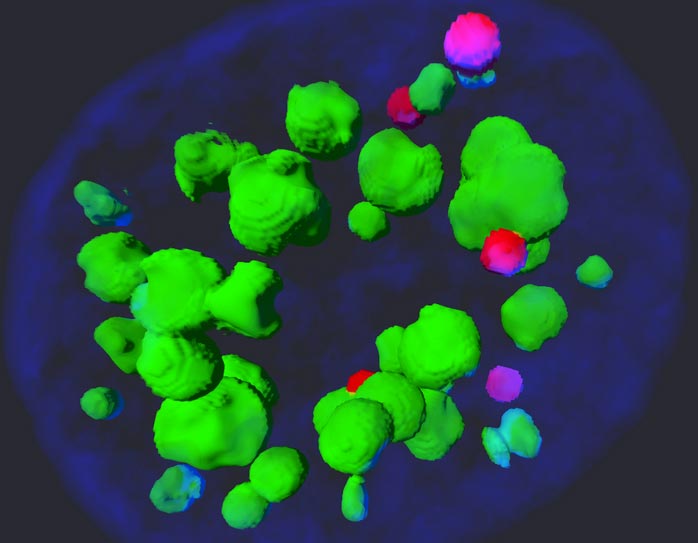UTSW scientists identify protein key to inhibiting flu virus

Nuclear speckles (green) shown inside a host cell nucleus. Protein complexes (red/pink) regulate its assembly and function.
Credit: UT Southwestern Medical Center
Down-regulating TAO2 prevents influenza from replicating in cells and could provide new target for antiviral therapies.
A collaborative study from UT Southwestern scientists has identified a new function for a protein called TAO2 that appears to be key to inhibiting replication of the influenza virus, which sickens millions of individuals worldwide each year and kills hundreds of thousands. The findings were published in PNAS.
“These results uncover new strategies for interfering with influenza virus replication, providing a potential avenue for the development of new antivirals against influenza,” said Beatriz Fontoura, Ph.D., Professor of Cell Biology at UT Southwestern, whose lab studies the interplay between RNA viruses, such as influenza A virus, with their hosts. The study was led by Dr. Fontoura, together with first author and postdoctoral fellow Shengyan Gao, Ph.D., and Melanie H. Cobb, Ph.D., Professor of Pharmacology.
To replicate, influenza virus takes over parts of the host cell nucleus known as nuclear speckles, which then provide the virus an environment to express its genes. Dr. Fontoura and her colleagues, including experts in cell biology, molecular biology, and pharmacology, identified a novel role in regulating nuclear speckle assembly and function for the TAO2 kinase – a protein involved in transferring phosphate groups to other proteins.
“We found that TAO2 is needed to maintain the physical integrity and function of nuclear speckles. Among the functions of nuclear speckles is regulation of key steps in gene expression, which are usurped by influenza virus at these compartments to support viral replication. Consequently, by down-regulating TAO2 levels – or its kinase activity – we were able to inhibit influenza virus replication without causing major toxic effects to the host cell,” said Dr. Fontoura.
Other UTSW researchers who contributed to this study include Matthew Esparza, Ishmael Dehghan, Ke Zhang, Kimberly Batten, Tolga Cagatay, Jerry W. Shay, Elizabeth J. Goldsmith, and Zhijian “James” Chen.
Dr. Goldsmith holds the Patti Bell Brown Professorship in Biochemistry. Dr. Shay is a Distinguished Teaching Professor and holds the Southland Financial Corporation Distinguished Chair in Geriatrics. Dr. Chen is Professor of Molecular Biology and Director of the Center for Inflammation Research at UTSW, a Howard Hughes Medical Institute Investigator, and winner of the 2019 Breakthrough Prize in Life Sciences as well as holder of the George L. MacGregor Distinguished Chair in Biomedical Science. Dr. Cobb holds the Jane and Bill Browning, Jr. Chair in Medical Science. Drs. Chen and Cobb are members of the National Academy of Sciences.
This work was supported by grants from the National Institutes of Health (R01 AI154635, NIH R01 AI125524), The Welch Foundation (I1243), the Center for Research of Influenza Pathogenesis and Transmission, National Institute of Allergy and Infectious Diseases (NIAID) Center of Excellence for Influenza Q:40 Research and Response (Contract No. 75N93021C00014), and NIAID (Grant U19AI135972), National Cancer Institute (U54 CA260560 Project 2), and a Mary Kay Foundation International Postdoctoral Scholar Fellowship.
About UT Southwestern Medical Center
UT Southwestern, one of the nation’s premier academic medical centers, integrates pioneering biomedical research with exceptional clinical care and education. The institution’s faculty has received six Nobel Prizes, and includes 26 members of the National Academy of Sciences, 17 members of the National Academy of Medicine, and 14 Howard Hughes Medical Institute Investigators. The full-time faculty of more than 2,900 is responsible for groundbreaking medical advances and is committed to translating science-driven research quickly to new clinical treatments. UT Southwestern physicians provide care in more than 80 specialties to more than 100,000 hospitalized patients, more than 360,000 emergency room cases, and oversee nearly 4 million outpatient visits a year.
Journal: Proceedings of the National Academy of Sciences
Media Contact
News Team
UT Southwestern Medical Center
news@utsouthwestern.edu
Office: 214-648-3404
All latest news from the category: Life Sciences and Chemistry
Articles and reports from the Life Sciences and chemistry area deal with applied and basic research into modern biology, chemistry and human medicine.
Valuable information can be found on a range of life sciences fields including bacteriology, biochemistry, bionics, bioinformatics, biophysics, biotechnology, genetics, geobotany, human biology, marine biology, microbiology, molecular biology, cellular biology, zoology, bioinorganic chemistry, microchemistry and environmental chemistry.
Newest articles

Innovative 3D printed scaffolds offer new hope for bone healing
Researchers at the Institute for Bioengineering of Catalonia have developed novel 3D printed PLA-CaP scaffolds that promote blood vessel formation, ensuring better healing and regeneration of bone tissue. Bone is…

The surprising role of gut infection in Alzheimer’s disease
ASU- and Banner Alzheimer’s Institute-led study implicates link between a common virus and the disease, which travels from the gut to the brain and may be a target for antiviral…

Molecular gardening: New enzymes discovered for protein modification pruning
How deubiquitinases USP53 and USP54 cleave long polyubiquitin chains and how the former is linked to liver disease in children. Deubiquitinases (DUBs) are enzymes used by cells to trim protein…



